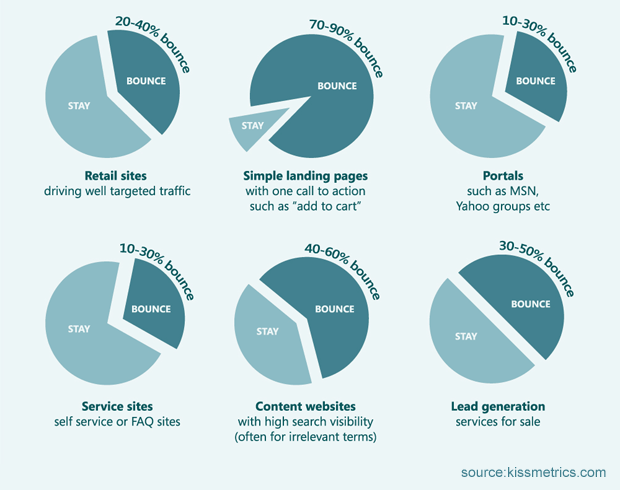The one strategy that actually reduces bounce rate
Bounce rate matters
Bounce rate measures how quickly people leave your website. It matters for Google because they rank pages with a lower bounce rate more highly. But it matters more to you because you want people to stick around your website. If you did all of the work to drive traffic to your website, then you want to be sure that they are sticking around and eventually signing up for something, buying something or otherwise engaging with you.
There are a lot of tips, tricks, and tactics to reduce bounce rate. A/B testing of content, a better users experience, better graphics all help. But start at the beginning. Start by making the site about the visitor, not about you, show them something interesting and they will listen and consume more content.
What is bounce rate and what is a good one.
Bounce rate is the percentage of visitors who visit a page without going to a second page. If a page has a bounce rate of 90%, that means that 9 out of 10 visitors do not visit a second page.
If you have paid for traffic, either through ads or endless SEO efforts, that means you are wasting 80% of your effort/spend.
You won’t get a bounce rate of 0%; in fact, anything below 20%-25% is probably a problem with your analytics. But even moving the needle from 90% to 70% or 60% can have a massive impact on your business.
Just moving from a 90% bounce rate to a 60% bounce rate effectively quadruples your traffic (because people are engaging not just landing and flying away).
This chart from Kiss Metrics shows some different expected bounce rates – notice how they change based on industry and what the site is trying to do.
A simple landing page with a specific call to action is very focused on the sale, so I either like it, or I don’t. Portals have lots of click options and opportunities to engage, so the bounce rate is lower.

What you need to take away from this is:
-
Lower is better, so do something to lower your bounce rate.
-
There are limits to how low you can go – any improvement can be huge for sales.
-
The target bounce rate depends on the market and what you want people to do when they land on your website.
So now, how do you reduce bounce rate?
Start by understanding that your audience likely has an attention span of just 8 seconds.

According to a 2015 study paid for by Microsoft, this is one second less than a goldfish. Humans have shorter attention spans than goldfish.
Why? Who knows?
The study suggested that all of our screens and the constant stream of distractions they provide has changed the way we think about and perceive the world and shortened our attention span.
Or this could be about survival. There are too many messages and too much stuff coming at us all the time. So we have to decide what matters and, well, what doesn’t and we have to do this quickly.
The reason doesn’t matter. Nor does trying to understand how one studies the attention span of a goldfish. If you are growing your business and want people to look at your website, engage with your stuff, and buy from you know this:
you have 8 seconds to grab the attention of your audience.
Use the short attention span to your advantage – make it about them
Most websites are lousy.
Most content on websites is not engaging.
And therein lies the opportunity.
Since most people are not engaging their audience, if you simplify your content and focus on your story, you can use those 8 seconds very effectively to engage visitors.
Once they are engaged, they will ask questions, and the act of asking questions, the curiosity, starts to draw them into your world. Curiosity expands visitor interest. Their attention span grows, and they want to learn more.
How to use your 8 seconds effectively:
1. Focus on the problem you solve and make it about them
Notice the singular here.
You can’t focus on many problems; you must pick one — the key challenge, the fundamental problem that your target market has.
There will be opportunities for nuance later, but here it is all about the one problem.
At Engage, for example, we solve many problems: communication, marketing, funnels, websites, design, but these are all details.
The real problem we solve: we double businesses.
The rest comes later.
The objection that comes up here is that “I don’t solve a problem.” Yes, you do. Think of it this way: all anybody ever buys is transformation. They buy something for what it does for them. You product or service must improve your prospects life in some way, or they won’t buy.
Talk about how you solve that problem and the transformation that you offer, not about the products, features, or benefits. Show them what is possible for them by working with or purchasing from you.
2. Use a story framework, not features and benefits
Stories connect, lists of features and benefits don’t.
Daniel Siegel, Clinical Professor of Psychiatry at UCLA, has researched this and shown that the brain encodes facts delivered in stories differently than facts by themselves. In his words:
“Telling and being moved to action by (stories) is in our DNA.”
Jennifer Aaker, professor at Stanford, has done some research showing that:
“Stories are remembered up to 22 times more than facts alone.”
This doesn’t mean that you have to tell lots of anecdotes. Instead, rely on the structure of story to enhance your website. This makes it more engaging and encourages them to go deeper into your site.
3. Simplify your materials.
Focus on reducing what you say, so that it is concise and expresses your story.
Use compelling images that express how you solve problems and summary headlines that communicate your story and simple language that engages.
Remember that your marketing materials don’t need to communicate everything they need to draw your market in to ask the next question.
4. Include a call to action.
Define here what the next step is for your audience. If they are interested, how can they continue their exploration? How do they continue the conversation?
The first step can be as simple as encouraging them to scroll down or turn over the page.
From there, they can ask for more information, enroll in a newsletter, or get a white paper.
Or something like: Download our story template here, just as an example.
These steps will encourage them to take the next step as they continue the journey to being your customer: give them something to click and a reason to do it, and they will more likely continue their journey.
The essential key to reducing bounce rate is to engage your visitors
You have 8 seconds so what you say must be relevant to your audience, it must be about them.
Realize that a person is visiting your website, so address the needs that the person has.
A more straightforward, more refined, approach will make use of people’s precious 8 seconds so they will want to learn more and understand what you do. These four steps will help you get there.
Read more:


